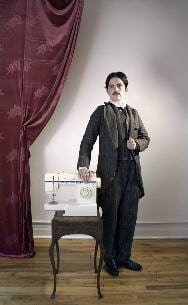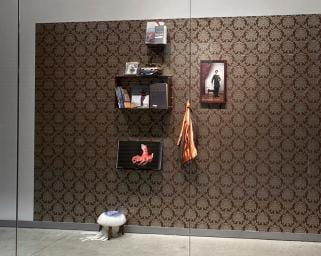
McPhee's drag persona, Cosimo, as seen in Libraries.
Libraries. Whether they be dingy, cramped rooms in our schools or venerable architectural masterpieces, their presence in our lives is unquestionably essential to our growth and education.
Or is it? Could it be possible that these storehouses of knowledge are, in fact, flawed in what they teach us and our children? Artist Nancy Anne McPhee thinks so and explores these themes in a new exhibition, called Libraries, at the Canadian Lesbian and Gay Archives in Toronto.
“We tend to rely on old models of thinking and organizing things,” McPhee says. “They see the world through a certain lens and have a perspective that is privileged, male, European and straight. I think we need to critique that.”
McPhee marries her love of textile art and a passion for library sciences in the exhibit, creating installations that reflect not only our society’s methods of collecting and storing information, but also unacknowledged historical perspectives from sects outside of what has long been considered the “norm” – including, of course, the queer community.
“For a long time everything that had to do with homosexuality was all lumped together in a manner that was not sufficient to actually access that material,” McPhee says. “Libraries have authority in cataloguing information and deciding on how things should be described. Once we mess around with these models, we realize that they’re not absolute, that they’re an invention.”
Two of Libraries’ installation pieces are rooms imagined by McPhee. There’s her Library of Depth and Gender, a collection of objects influenced by natural history, monster films and drag, as well as the Library of a Dandy, which features “artifacts” from the life of McPhee’s drag king persona, Cosimo.
“I wanted to create a library for me and for my life,” she explains. “I wanted to think about how bodies of knowledge relate to the human body and to interrogate ideas of things like gender and sexuality.”
The third component is an impressive series of 65 ink drawings of cephalopods, created by McPhee several years ago. She has long been drawn to squids and octopi and is excited about their inclusion in the exhibit.
“The thing I love about cephalopods is that they’re the opposite of the human body,” she says. “They’re soft, they’re uncomfortable and beautiful at the same time. In Toilers of the Sea, Victor Hugo describes a scene where he says he’d rather be eaten by a tiger because all it does is bite you. But an octopus drinks you.”
Libraries is a good fit for the CLGA in its exploration of how history is recorded and disseminated – particularly given that our own queer history has been so marginalized over the years.
“Nancy has such a wonderful archival sensibility to her installations,” says Karen Stanworth, director of the CLGA. “She brings these kinds of remains and traces alive for others in a way that can create an interesting tension between histories of gender and of sexuality.”
Given the show’s archival nature in including items from queer history, Stanworth hopes attendees will be inspired to engage more fully with the CLGA’s vast collection of stories, artwork, photographs and objects relating to a community whose history is often kept separate from the mainstream.
“There are so many people who don’t know some of these rich histories,” she says. “Our gallery space is really meant to allow those who have never been in an archive to walk through an archival space and see materials they wouldn’t otherwise experience.”
Libraries opens Fri, Oct 26 at 7:30pm with a public reception
Runs until Sun, Dec 2
Canadian Lesbian and Gay Archives
34 Isabella St
clga.ca

 Why you can trust Xtra
Why you can trust Xtra


